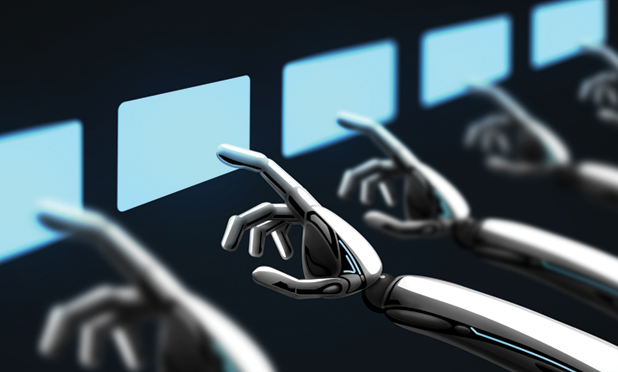We live in a time when science fiction can quickly become science fact. Within a generation, the Internet has matured from a technological marvel to a utility, and mobile telephones have redefined how we communicate. Health care, as an industry, is quick to embrace technology, so it is no surprise that the application of programmable robotic systems that can carry out actions automatically and artificial intelligence (AI), e.g., machines that learn, solve problems, and respond to their environment, is being keenly explored.
In fact, both technologies are already being put to work, and their use is set to expand rapidly. There are robotic systems, such as the da Vinci Surgical System, that assist with complex but minimally invasive surgery; rehabilitation robotics are helping patients regain physical function after strokes; and robots are helping elderly patients lead more active lives.
These advanced technologies are big business. Market intelligence firm Tractica forecasts that healthcare robot shipments will exceed 10,000 units per year by 2021. A further study by Allied Market Research suggests that the surgical robotics market will double from US$3 billion in 2014 to US$6 billion by 2020.
For its part, AI increasingly plays a role in the diagnosis of illnesses and the planning of treatment programs. Expert systems that scan the rapidly growing body of scientific literature are helping clinicians achieve more accurate assessments of patients in a shorter time. For instance, the new GP at Hand service launched in London, which allows people to check symptoms through a mobile application and then have a video consultation with a doctor within two hours, uses AI to gather and analyze symptoms. Frost and Sullivan predict that the AI market for health care will increase 40% per year between 2014 and 2021, with revenues rising from US$633.8 million in 2014 to US$6.662 billion by 2021.

“We are on the threshold of a new pattern of using technology,” says Henrik Eriksson (right), professor of nursing in the Department of Nursing and Care at The Swedish Red Cross University College in Stockholm, Sweden. “It is driven by technological innovation in countries where people live longer and where there is a shortage of health care staff.”
“We have seen robots in traditional industry sectors like manufacturing for 40 years, and, through an entertainment industry in which science fiction is popular, we have seen a change in attitude toward AI and robots,” he adds.
For Better or For Worse
AI and robotics have been portrayed in popular culture as both assistive and destructive. It appears as though the world has a choice between R2-D2 and the Terminator. Even when we move from science fiction to science fact, there seems to be great concern about the potential of these technologies.
The late renowned scientist Prof. Stephen Hawking has warned that AI could spell “the end of the human race,” and, in a recent interview with the BBC, Prof. Nick Bostrum of the Future of Humanity Institute at Oxford University echoed this sentiment, stating that machine learning experts believe AI could overtake human capability by 2045.
Nevertheless, many patients welcome the use of more sophisticated systems. A recent study by PwC (formerly, PricewaterhouseCoopers), for instance, found that 39% of United Kingdom patients are willing to engage with artificial intelligence or robotics for health care. Among respondents aged 18 to 24, this figure rises to 55%.

“These technologies will play a massive role in the broader development of digital health technologies,” says Prof. Christoph Thuemmler (right) of Edinburgh Napier University’s School of Computing. “I believe that patients suffering from neurodegenerative diseases, such as macular degeneration, dementia, and Parkinson’s disease, will highly benefit from AI. Robotics will be huge in social robotics and, in the long term, in remote surgical assistance systems.”
“At the moment, complex artificial organs, such as brain pacemakers, cardiac pacemakers with built-in defibrillators, and especially smart pharmaceuticals, are working more and more with AI. Da Vinci operating robots are incredible machines that use AI algorithms at their core to enhance accuracy. Algorithms for the production of high-resolution digital images and holograms are also based on AI,” he adds.

Ana Cristina Barata Pires Lopes, Ph.D. (right), adjunct professor in the Automation and Robotics for Human Life Group at the University of Coimbra, Portugal, is among the many who see a bright future for assistive robotics to help the elderly.
“Taking into account the great aging of the population in Western countries, I believe that assistive robotics to improve mobility and autonomy of senior people will see great development,” she remarks. “In terms of R&D, there are many areas of robotics devoted to improving patient care, in particular, mobile robotics, such as robotic wheelchairs, smart walkers to help with patient mobility, or personal assistant robots to help with medications and other everyday tasks, robotic manipulation systems for grasping objects, rehabilitation robotics, and social robotics.”
A Meeting of Minds
Lopes is currently working on a project to develop a personal remote-assistant robot. One of the project’s aims is to create new methods for local and remote human–robot interaction, focusing particularly on social aspects. She accepts that, for robotics to play a more prominent role in health care, there are many hurdles still to clear.
“These types of technological solutions need to be certified because safety must be fully ensured when it comes to technology that deals directly with people’s well-being and health,” she says. “In recent years, many robotic prototypes devoted to patient care have emerged. However, I believe that safety still remains a weakness of many of them. Giving the example of robotic wheelchairs, it is very difficult to obtain a product that is totally safe at a competitive price.”
Furthermore, there are some healthcare contexts in which the role of AI and robotics may remain limited. Nursing is a prime example.
“Nursing relies on communication between humans, so there is some reluctance to use technology in that area, partly for ethical reasons and partly because of the need for personal contact,” Eriksson explains. “The younger generation of nurses will be more accepting of technology as a companion for small tasks. We will see electronic pets for patients with Alzheimer’s and exoskeletons for people who cannot walk for themselves, and those systems will come very quickly.”
“That technology, and systems for patient monitoring and surveillance, is moving so fast,” he adds. “But we will also see algorithms that will search databases to constantly review best practice in the treatment of many illnesses because humans cannot keep up with the explosion of scientific literature. In nursing, however, intuition and empathy are very hard for AI, though we will see socialized robots for companionship and entertainment.”

Mark Coeckelbergh (right), professor of technology and social responsibility in the School of Computer Science and Informatics at the University of Vienna, Switzerland, has looked specifically at the applications of robotics in health care and sees widespread acceptance among patients.
“There are already robotic systems that operate on people, and patients have little problem with that,” he says. “People are comfortable with automated airplanes. In the future, we will see robots in applications such as nursing, which is usually human labor-intensive, though they will probably assist rather than replace nurses.”
“Patient acceptance depends on their age,” notes Eriksson. “There is a lot of evaluation being done with older patients now, and it comes down to independence. Solutions that maintain daily independence are welcomed more than systems for surveillance, for example; so, if a system reduces a patient’s reliance on other people, it is likely to be highly appreciated. In some ways, technology can be more reliable because it has a more consistent approach to managing a problem than a human. But healthcare professionals have a personal touch and can deliver a wider range of assistance.”
The Ethical Equation
As new technologies become more central to the delivery of patient care and, in the case of AI, in the decisions made about treatment, the matter of accountability becomes paramount, and the question of who is in control arises. Eriksson has looked at the use of robotics and AI in nursing and the potential to develop machines that exhibit empathy for human patients. In his Caring Monsters Project, he has considered the evolution of monsters in popular fiction as a metaphor for the relationship between humans and machines and as a way to prepare ourselves for the growing use of AI and robotics.
“The project is necessary because we don’t have a place to evaluate the technology before we create it, which is why we look at monsters,” he explains. “We can’t just let technology drive itself. We must engage in ethical discussion at the same time as technology development. New ideas cross the world instantly and get global exposure, so we need to get people working in social sciences and nursing sciences to focus on their ethical obligations and not just leave it to the scientists and engineers. Technology develops so fast that the human element can be left behind.”
“Ethically, people are nervous about specific tasks that require human feeling—empathy and compassion—being performed by robots,” adds Coeckelbergh. “There is a lot of research and investment into robots in this context, but they will not take over. People are more worried about the ethics of invisible changes, i.e., the technology behind the curtain. This could be health applications using our data, general practitioners using AI without patients knowing, or decisions being silently made by the technology. The ethical debate is, therefore, more in the area of software. Responsibility and accountability are big questions. Who is responsible if something goes awry?”
Coeckelbergh sees great benefit for patient outcomes in the synergy between human judgment and systems that can conduct automated analysis of a large body of data to aid diagnosis and make recommendations for treatment. As he explains, “Humans are good at combing information and finding creative solutions, but a robot could help. Collaboration could be the way forward so that machines are not making decisions on their own. People are already becoming more aware of ethical issues than they were in the past, but they need to be supported with tools, investment, and the expertise of people who specialize in ethical matters.”
Many steps have already been taken to ensure that ethical issues are addressed early in technology development. For example, responsible research and innovation (RRI)—part of the European Union’s Horizon 2020 program—is an approach that anticipates and assesses potential implications and societal expectations with regard to research and innovation.
RRI is a sign that funding agencies can and should play a role in specifying that ethical reflection must be part of the design process. For technology companies, the answer could be regulation alongside a process of education to get people thinking about ethics and accountability as a fundamental part of their work.
The basic requirement is that technology developers and healthcare professionals decide clearly what role robots and AI should play. Instead of reacting to the capability of new technology, the industry must define its development.

“We have to remember that care robots have not had a big impact yet; they are nowhere near being safe or stable enough to do anything useful,” says Bernd Stahl (right), professor of critical research in technology and director of the Centre for Computing and Social Responsibility at De Montfort University, Leicester, United Kingdom. “AI will have a big impact in diagnosis and personalized health care, but there is resistance among healthcare professionals toward autonomous systems. Computer systems will support doctors’ decisions, so the doctor always remains responsible. The ethical question is one for both technology developers and healthcare professionals, and it should really focus on how people and systems interact,” he adds.
The key message is that health technology must develop in a human context and not dictate the agenda.



